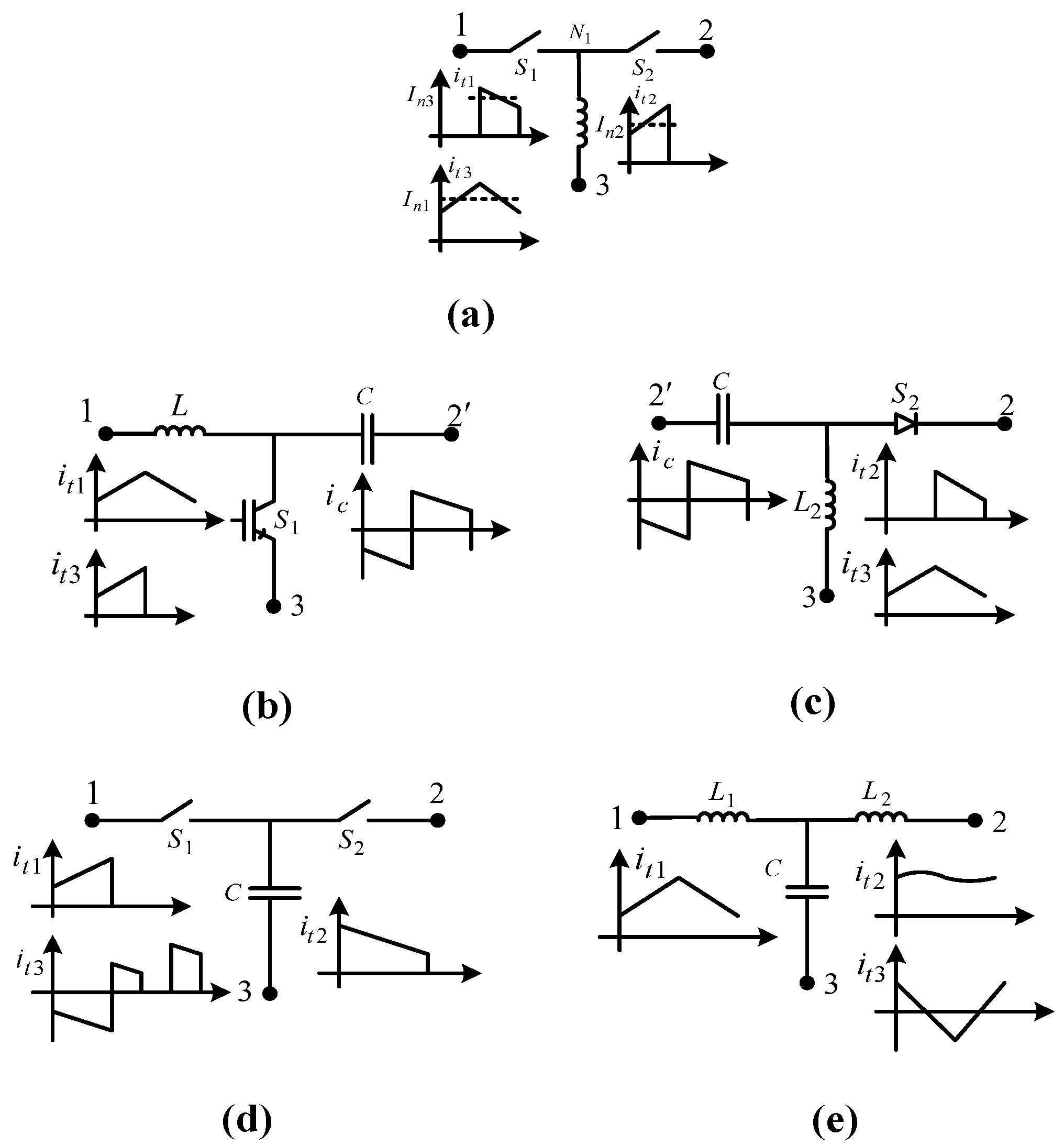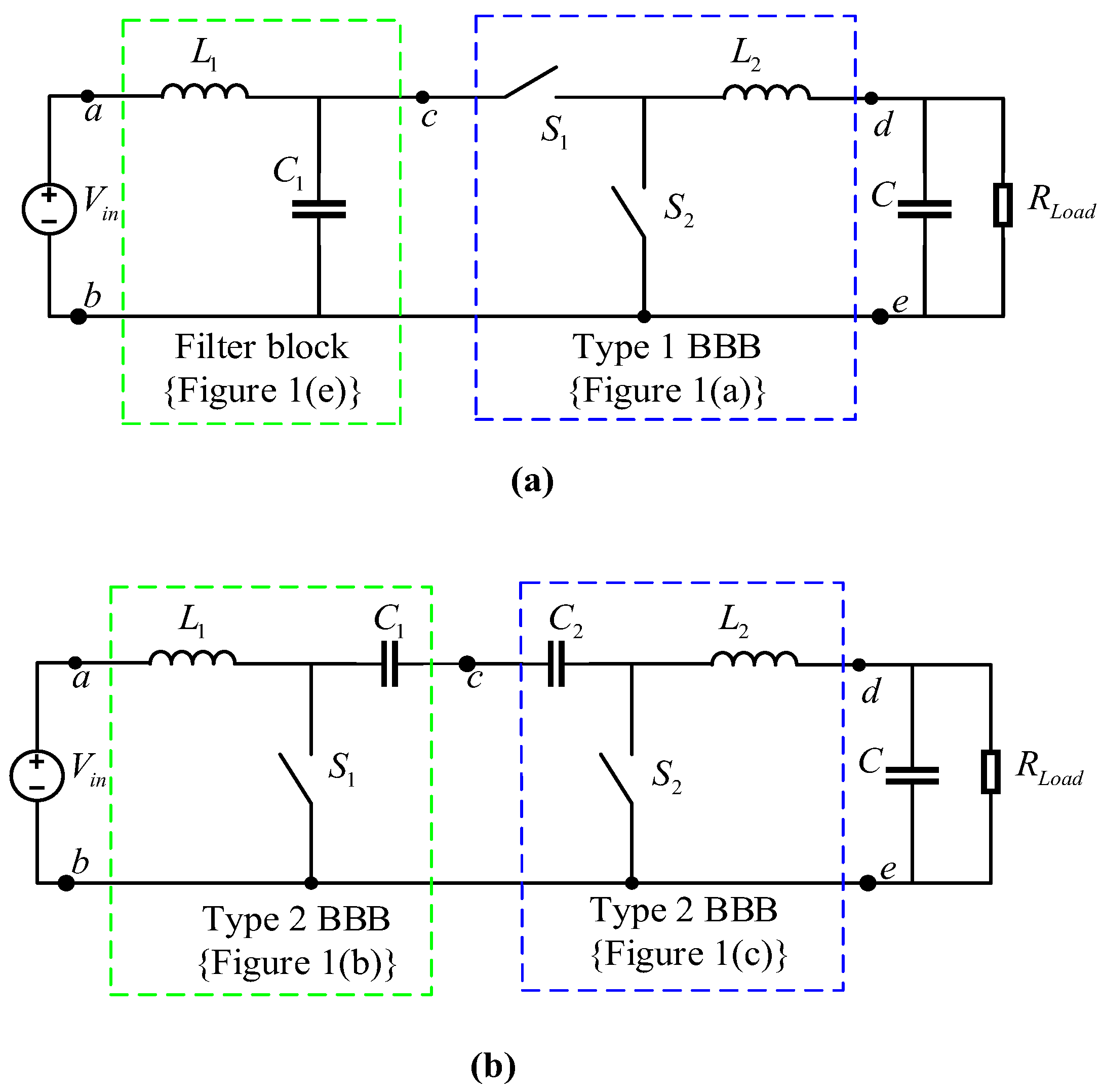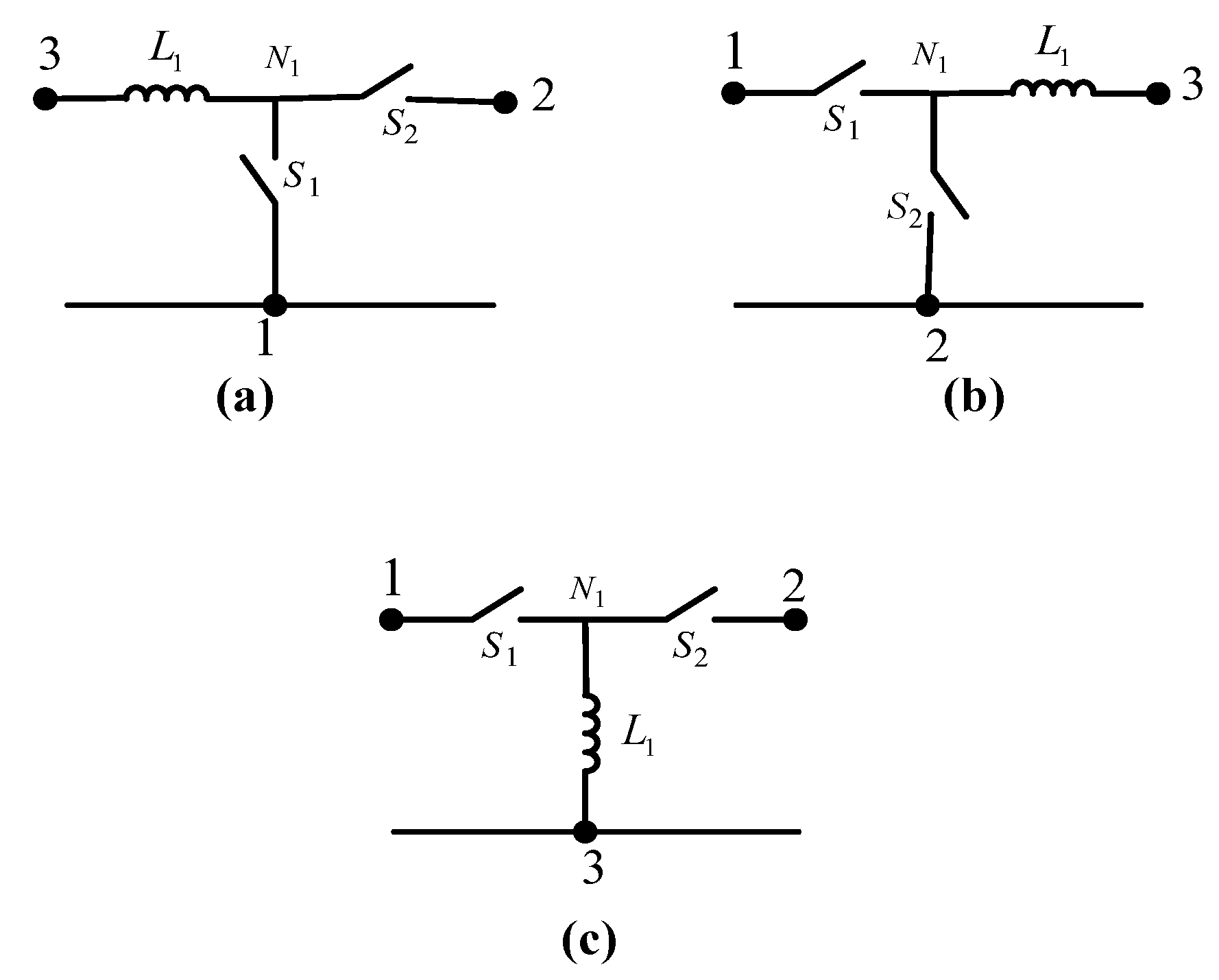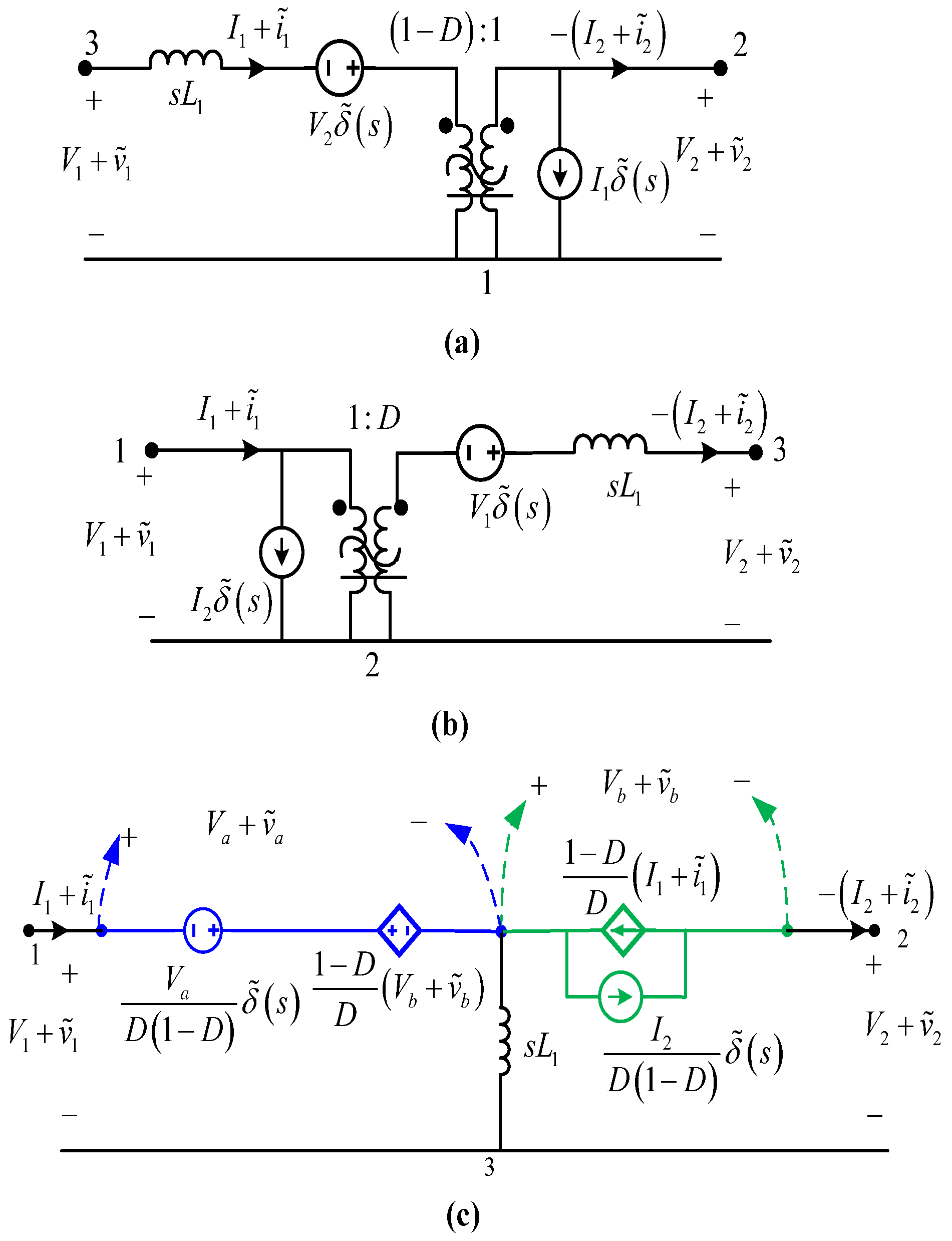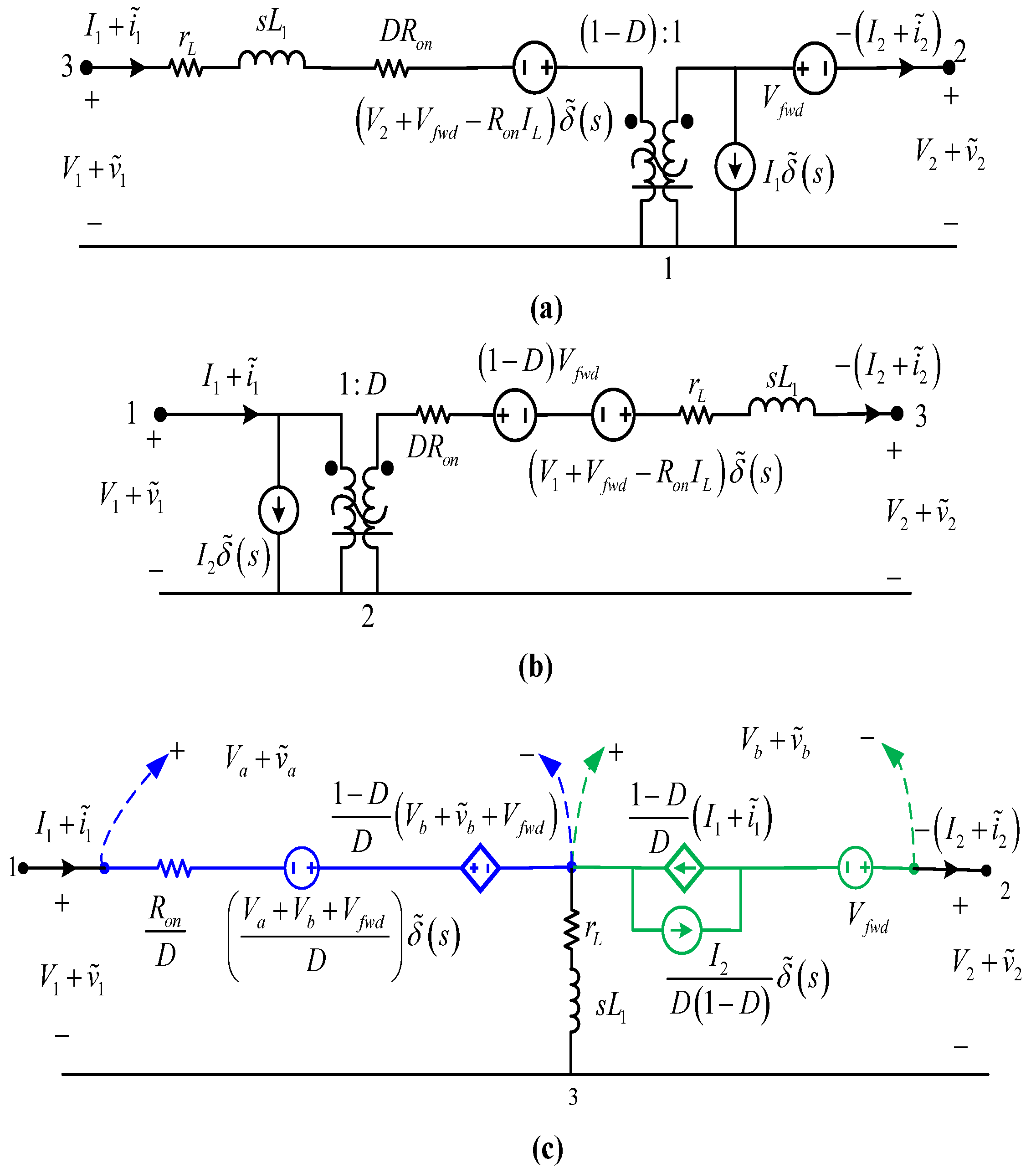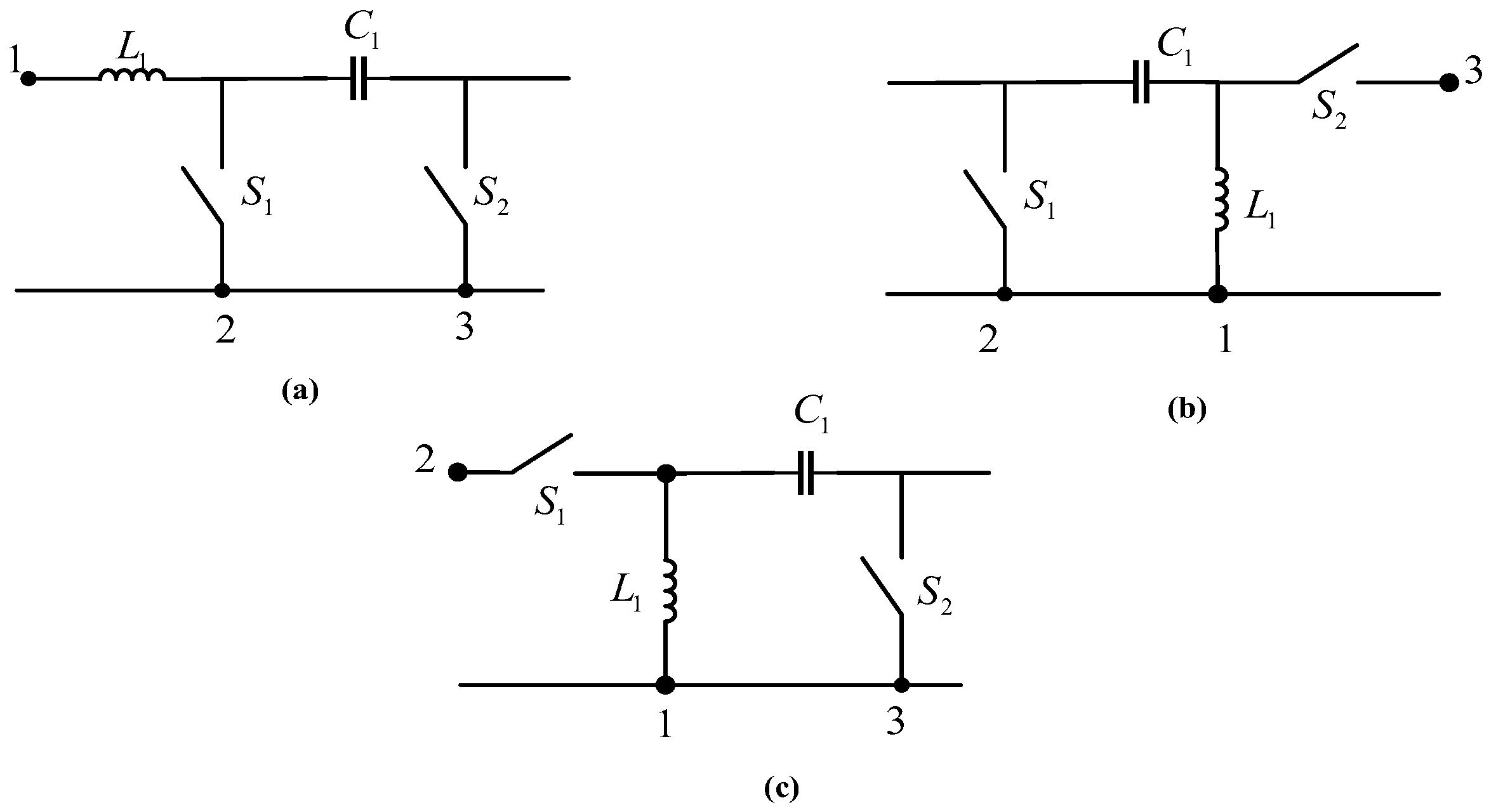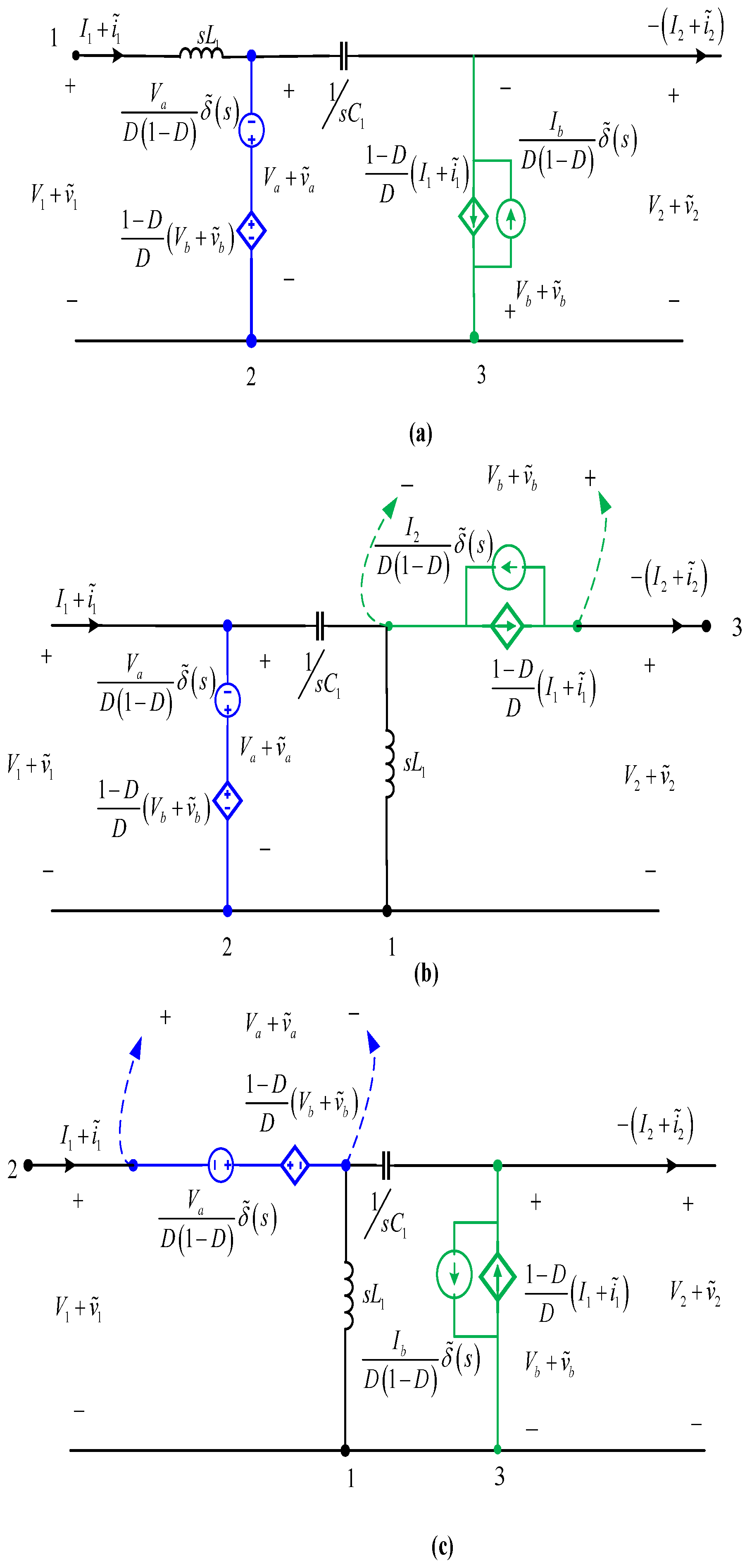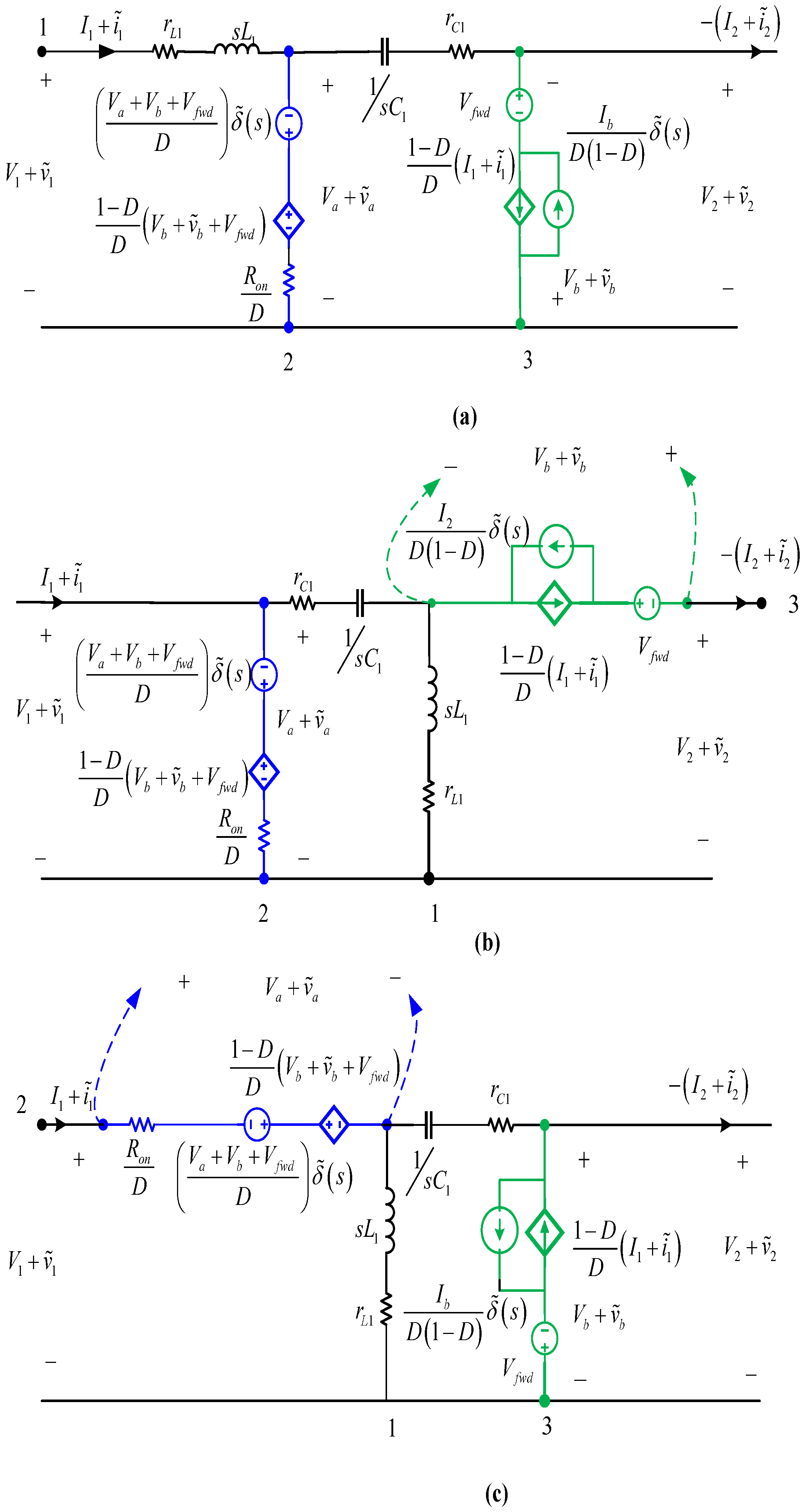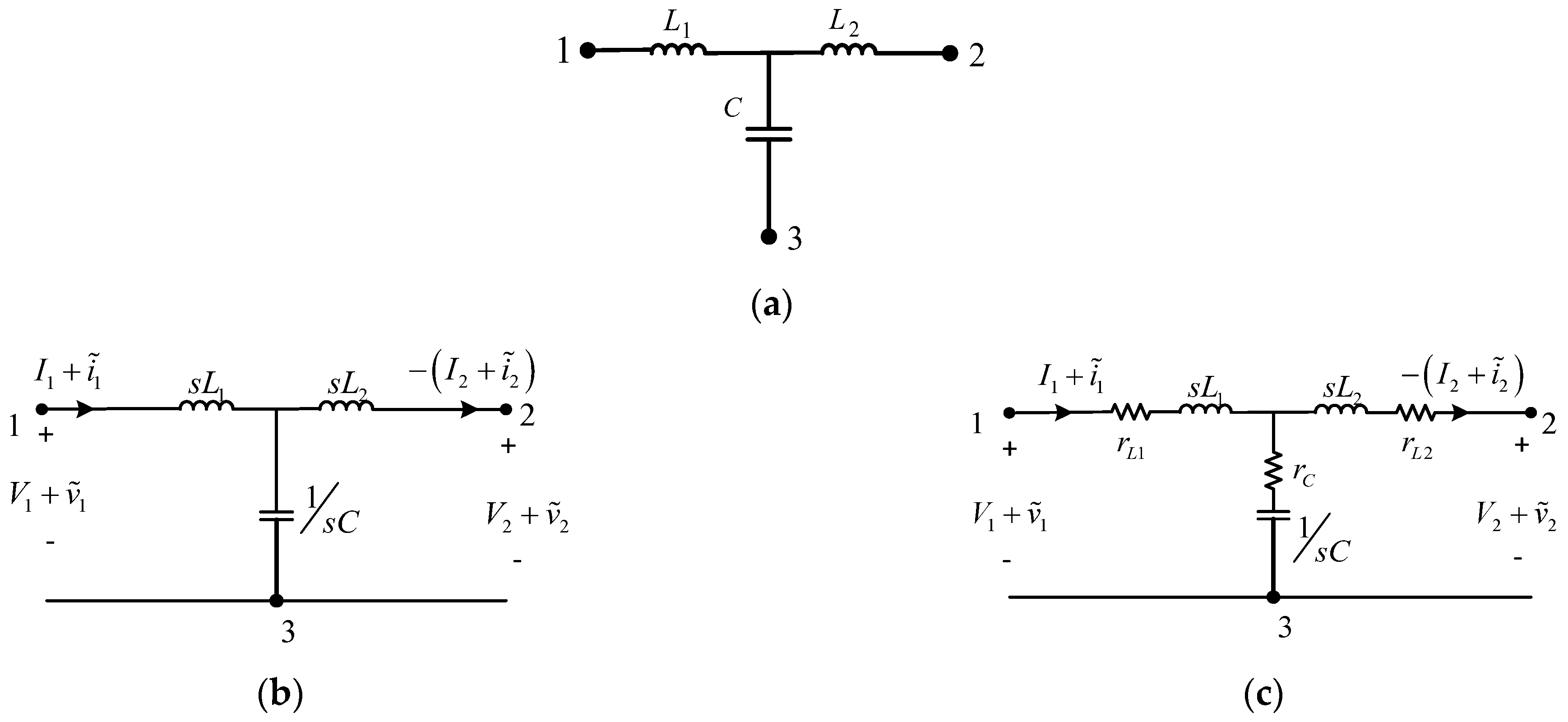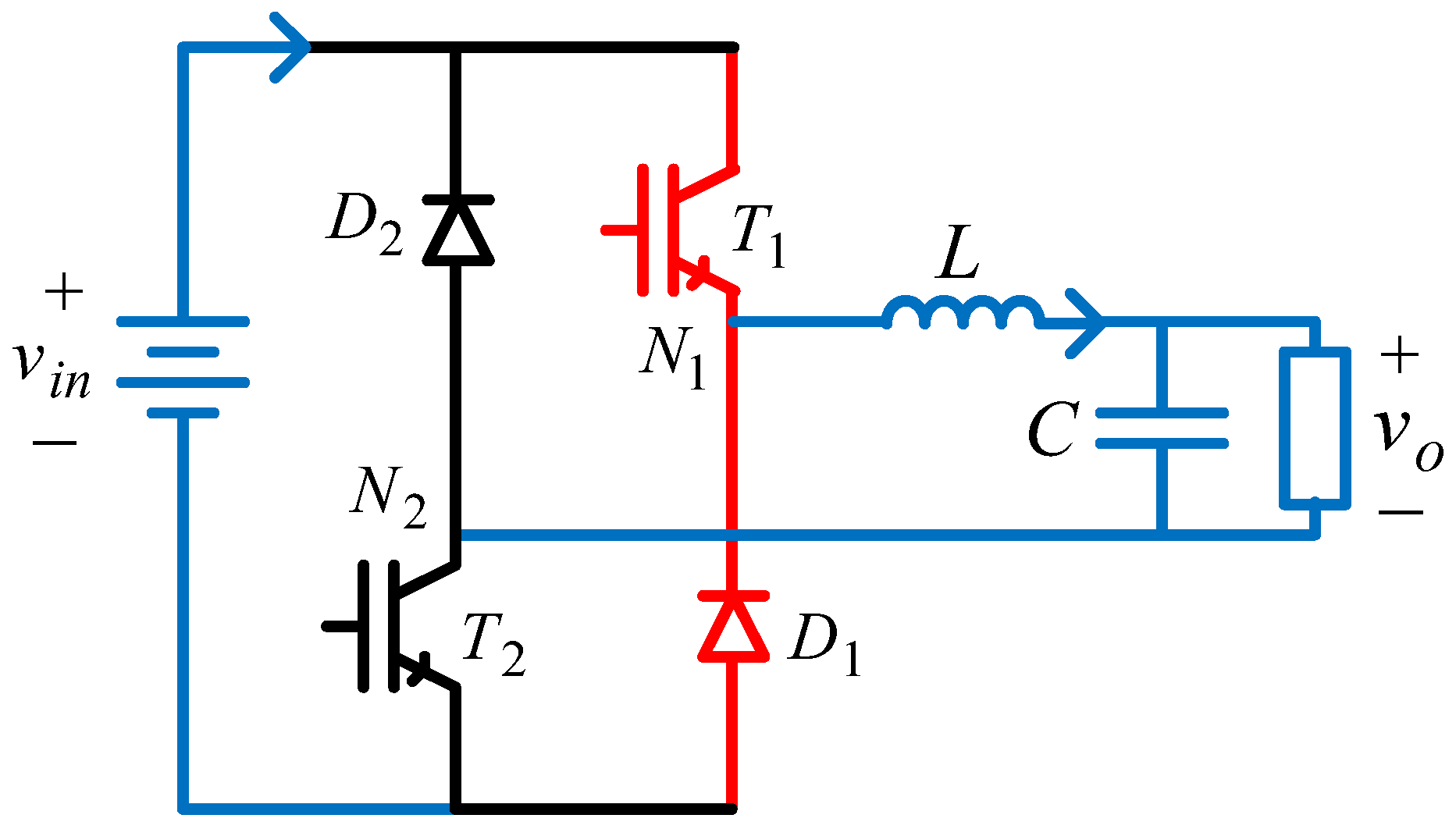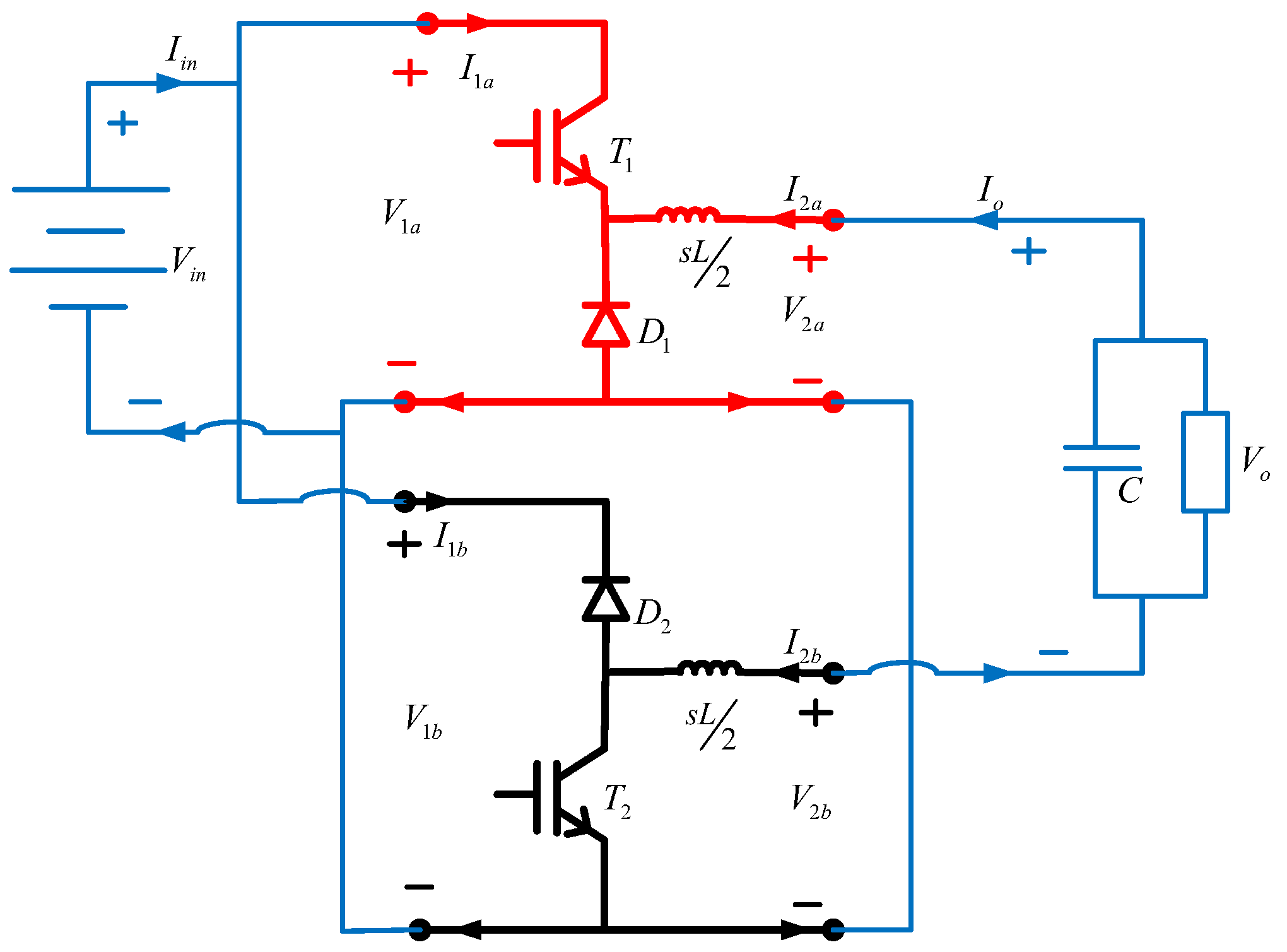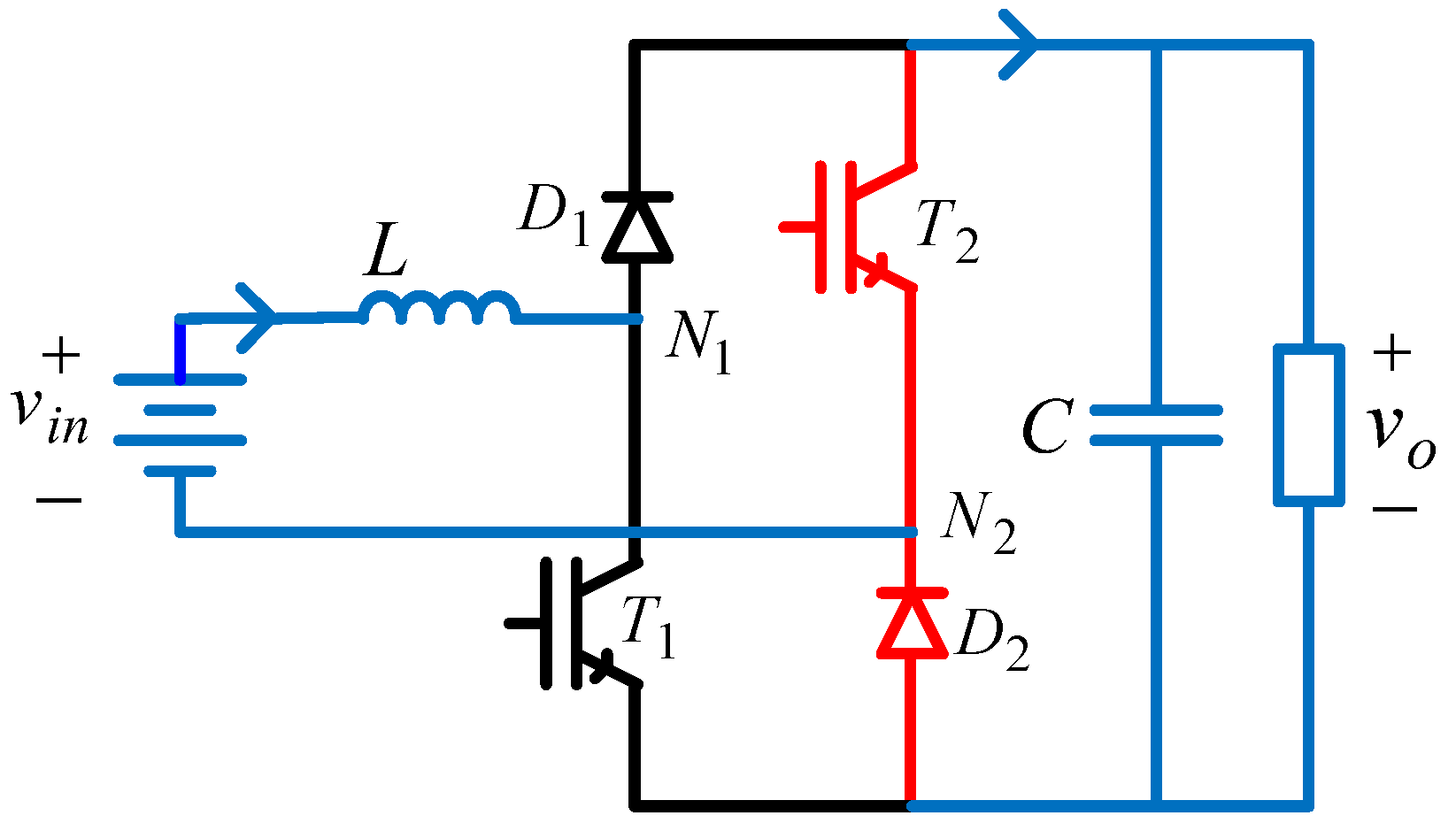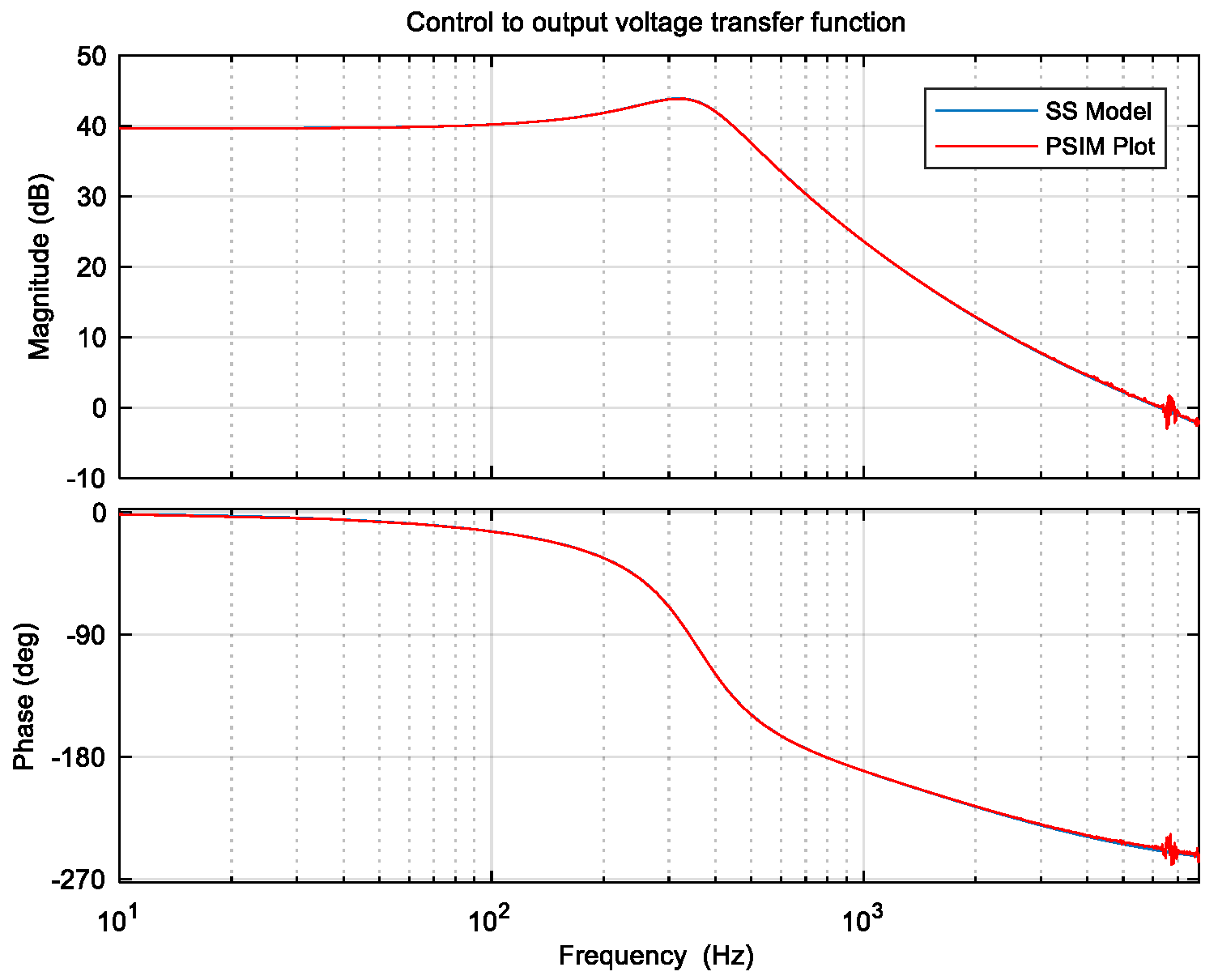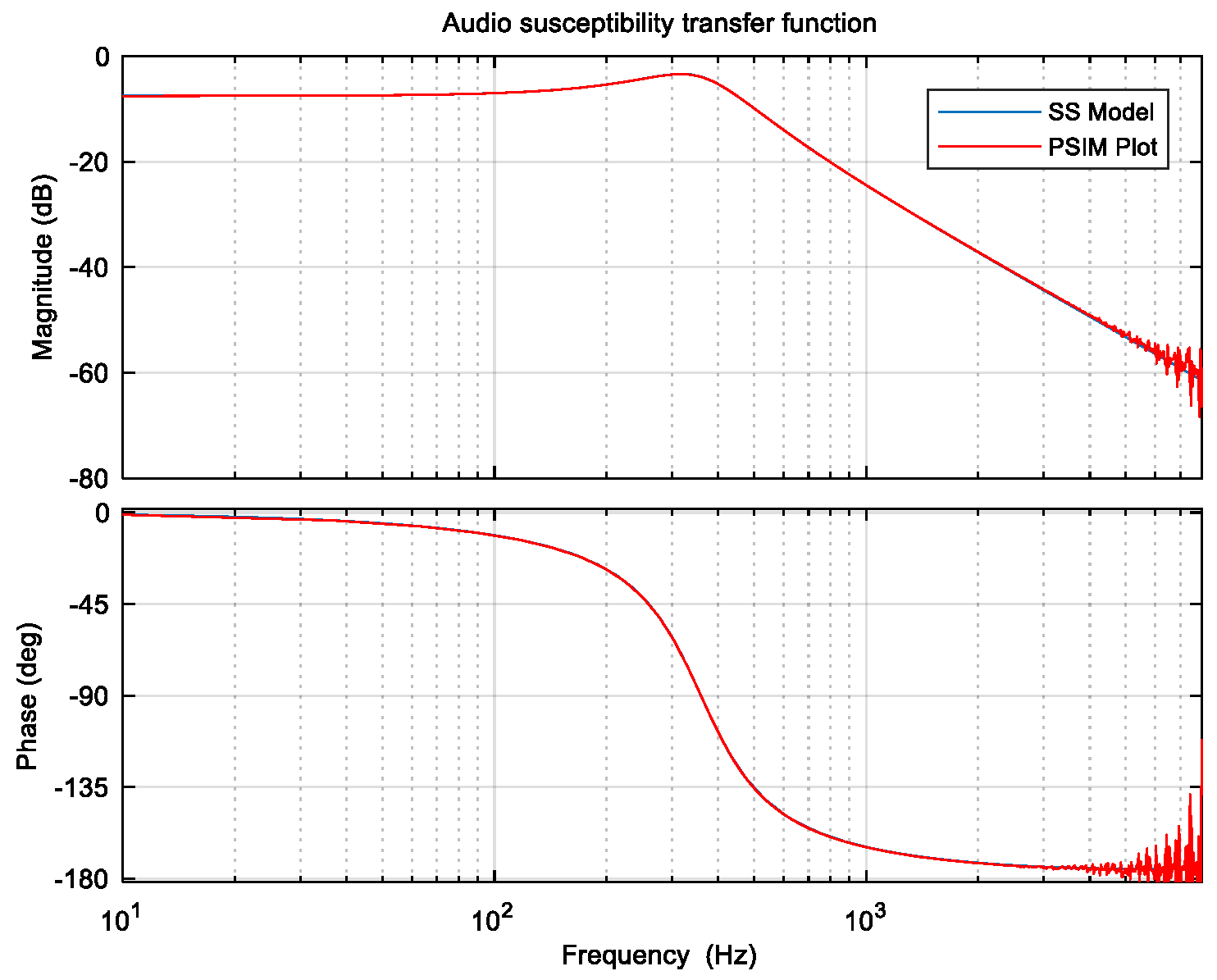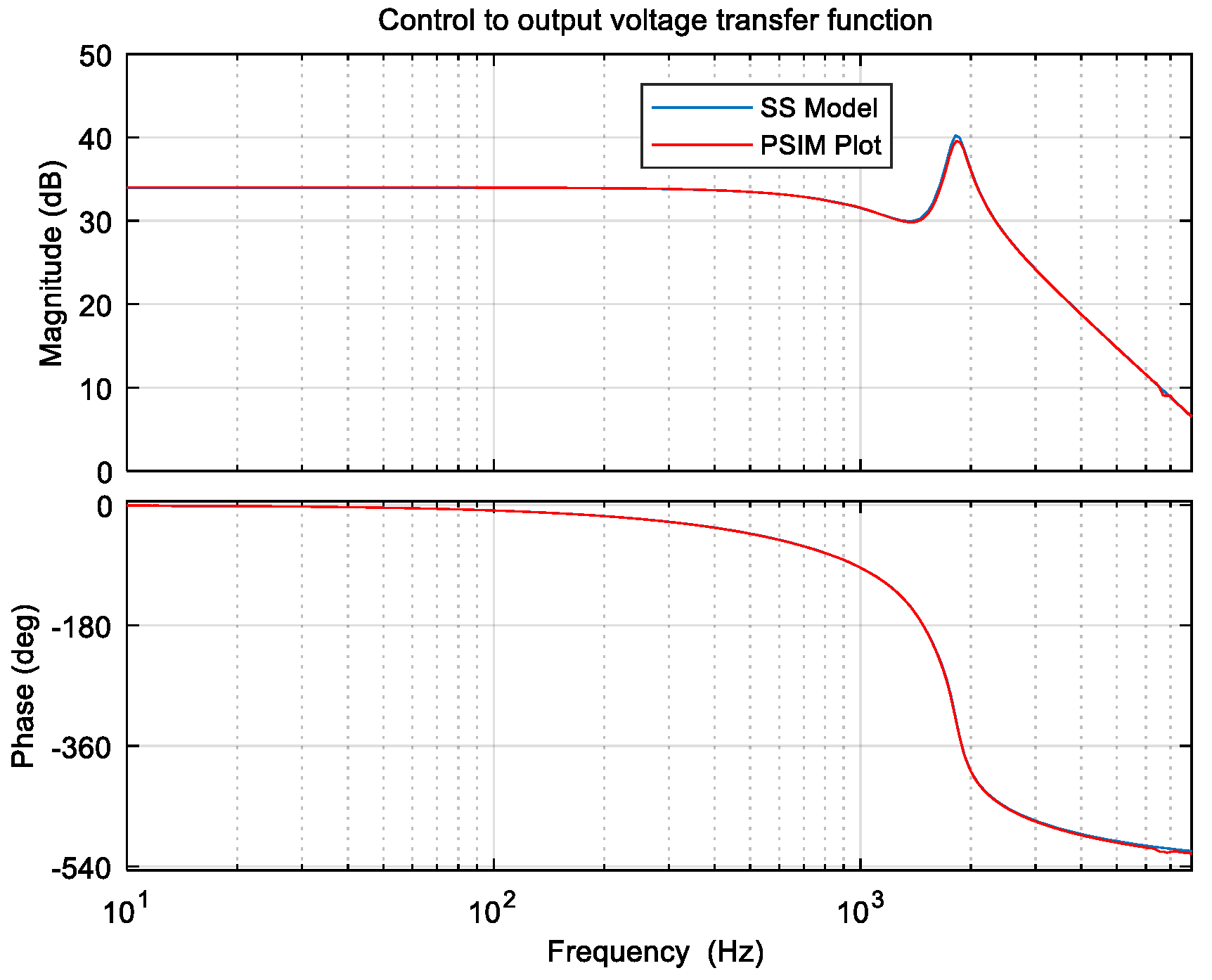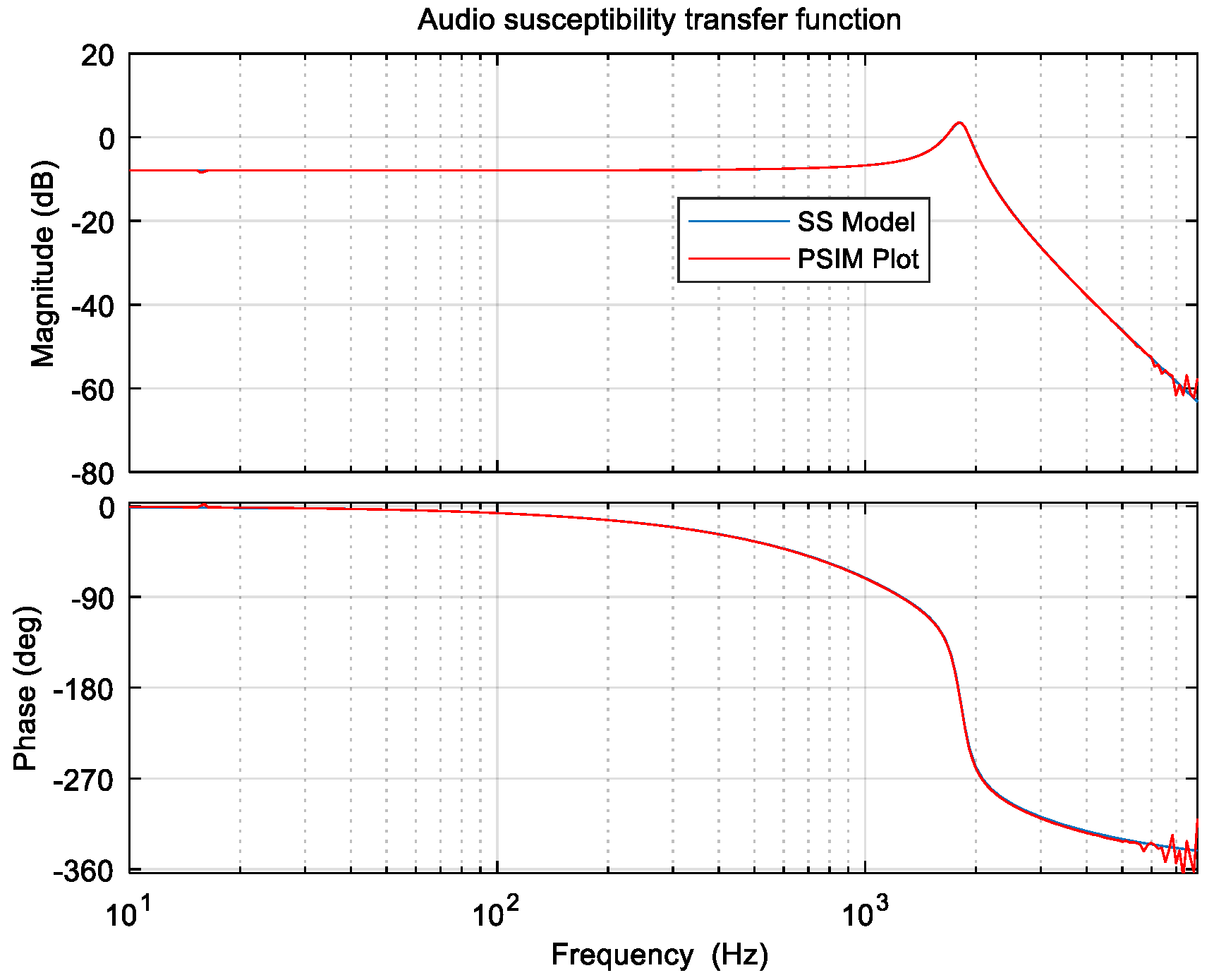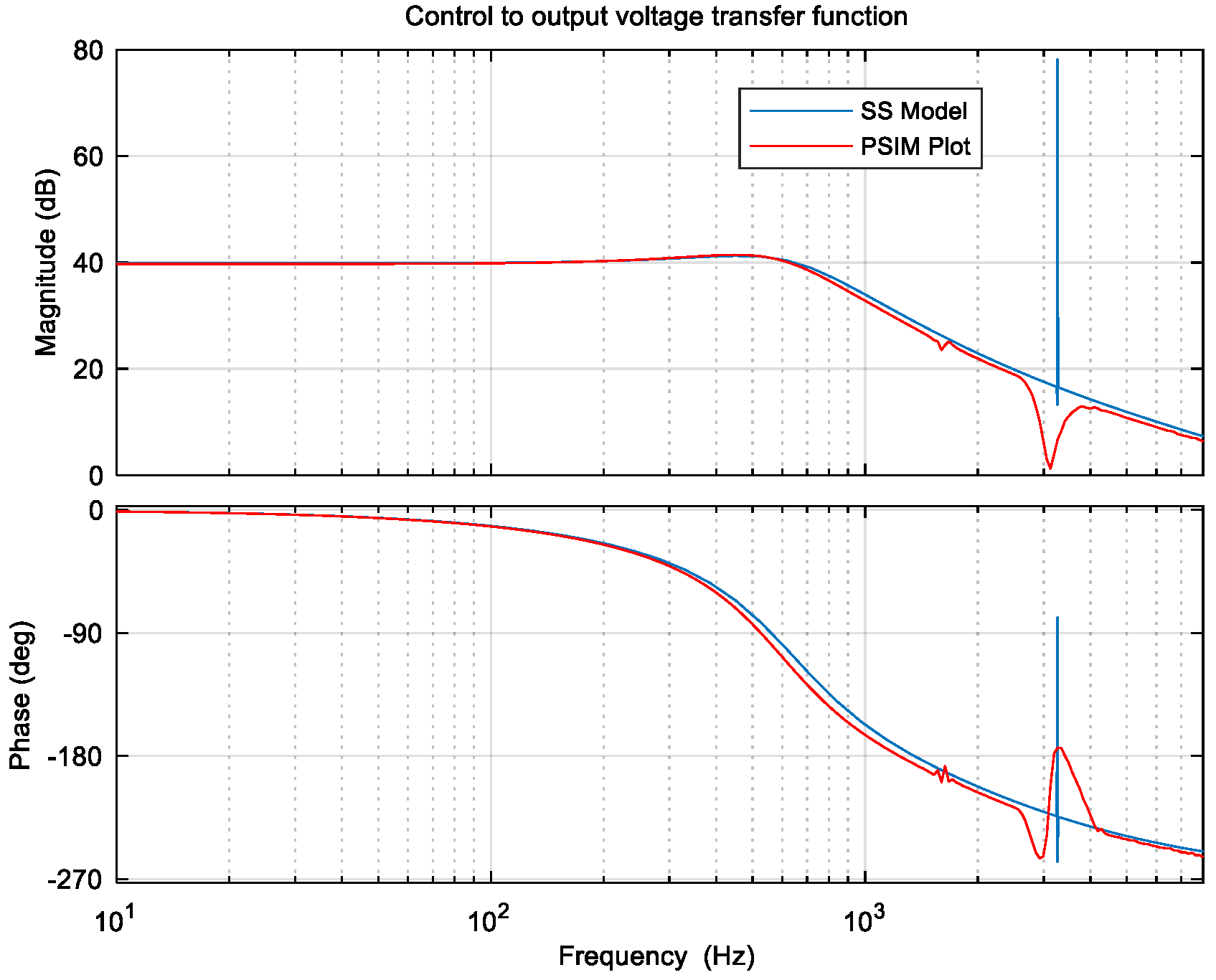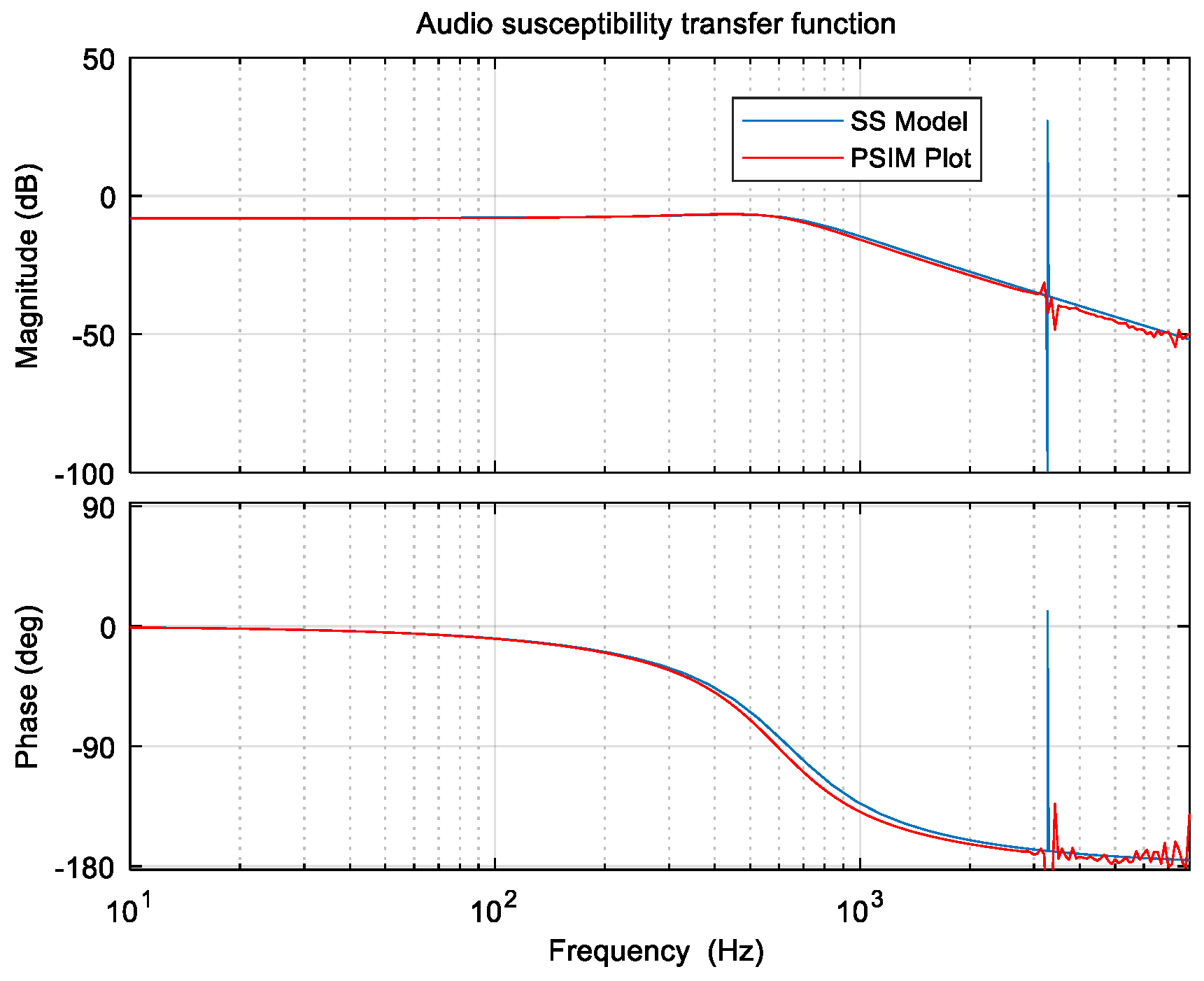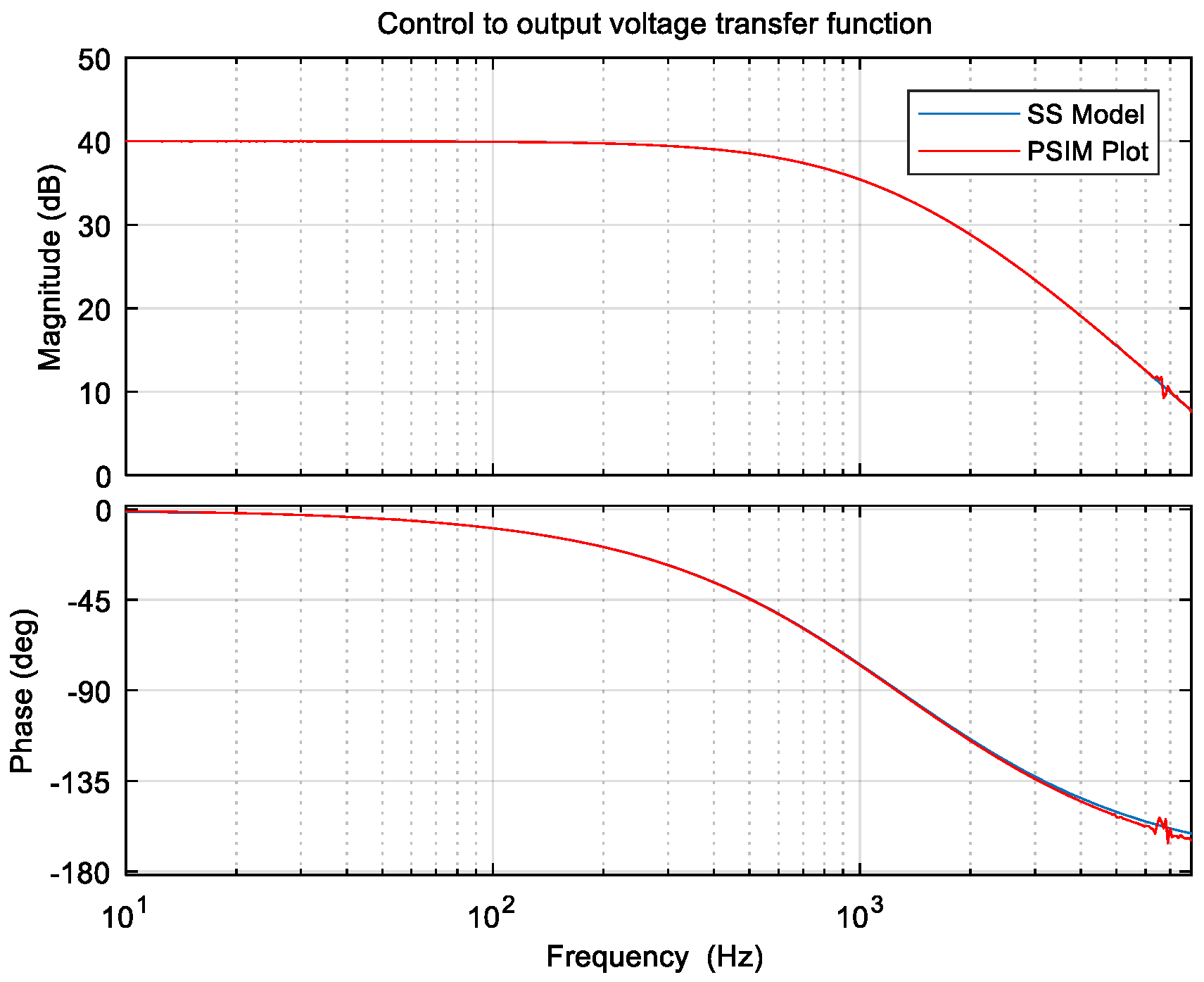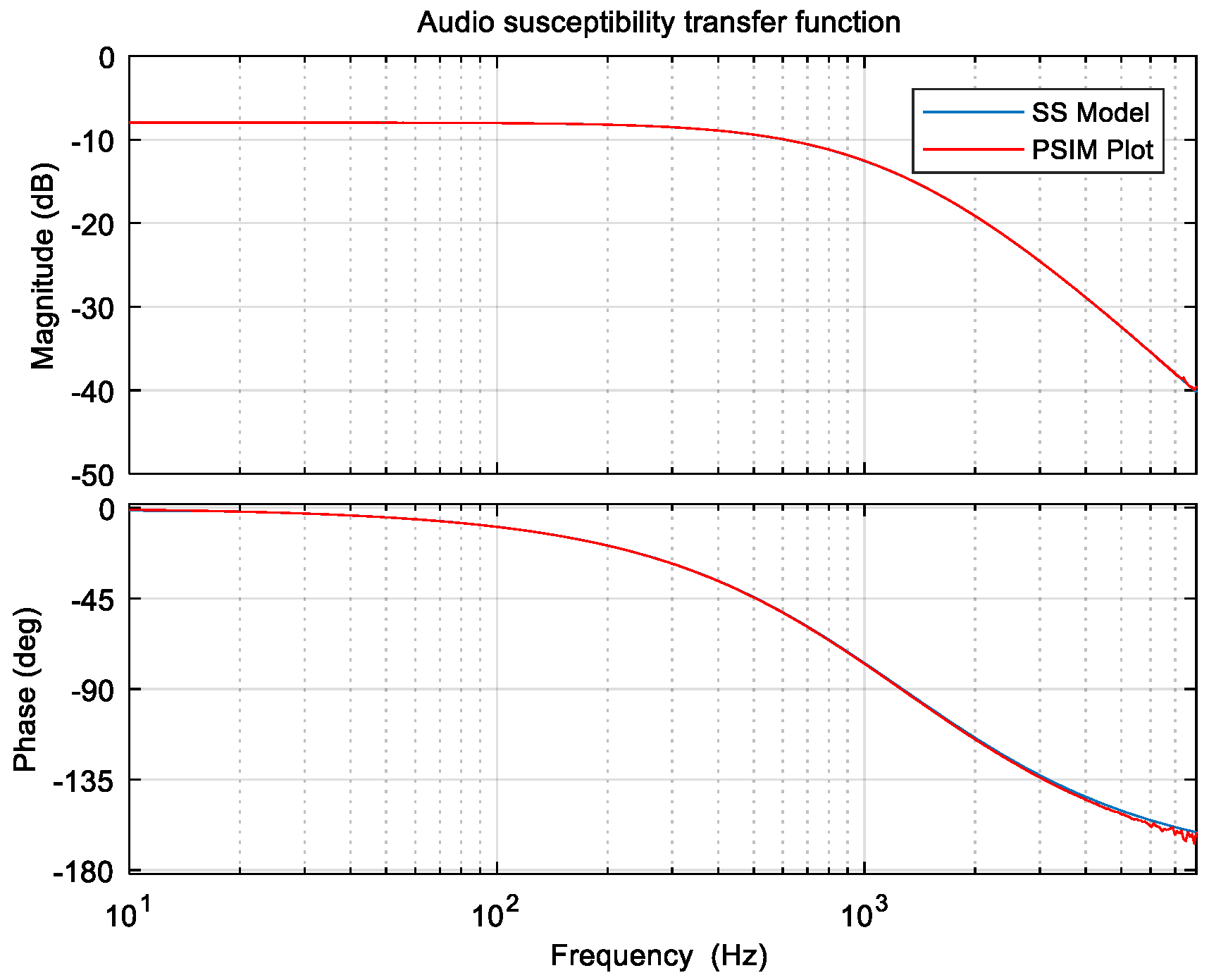1. Introduction
The role of a DC-DC converter in a DC microgrid can loosely be equated to that of the AC transformer in the conventional AC grid. Unlike AC transformers, which are mostly passive devices, these converters employ switching schemes to function [
1,
2,
3,
4]. Additionally, these converters have a more direct influence on the performance of the entire DC grid, since they can be used to extract maximum power from a source [
5,
6,
7], actively transfer charge into an energy storage device [
8,
9], correct the system power factor [
10], emulate a source [
11,
12], and mask the intermittence of renewable energy sources (RES) [
5,
7], etc. Functions such as active power control will typically be the sole responsibility of generators in an AC grid [
13]. The versatility of DC-DC converters is enabled by the controller’s ability to determine a correct duty ratio for the active switches for any operating point [
7,
10,
11,
12]. Moreover, such versatility makes these converters critical in the mission to achieve net-zero carbon levels and ultimately combat effects of global warming, because power from RES cannot be directly used for most practical applications [
3,
14,
15,
16].
The switching nature of these converters makes them inherently non-linear [
17,
18,
19]. This non-linear nature renders the direct use of classical control methods futile since they rely on linear models [
18,
19]. As such, pseudo-heuristic modelling techniques, such as state-space averaging [
20], circuit averaging [
21], and a switching flow graph [
22], were developed to arrive at a linear model for these converters such that linear control methods such as proportional, integral, and derivative (PID) control can still be used [
18,
19]. The derivation of models from these pseudo-heuristic modelling techniques is somewhat laborious and the algebra easily gets intractable and complex with higher-order converters [
17,
21,
23]. For DC microgrids, these converters are deployed in large numbers to perform specialized functions, including voltage regulation [
24,
25]. The deployment of a specific type of converter at any point in the microgrid is dependent on the application of interest and accompanying design specifications [
5,
6,
7,
24,
25,
26,
27]. There is a plethora of DC-DC converter topologies to choose from, each with known merits and demerits [
28,
29,
30,
31,
32,
33,
34]. To deal with the proliferation of converters, researchers have introduced organizational tools to identify, classify, and deduce insights pertinent to the genesis and overlapping traits among available DC-DC converters. Among these organizational tools is the use of converter cells [
28], the minimum separable switching configuration (MISSCO) [
35], PWM switches [
36,
37], layer schemes [
38], graft schemes [
39], circuit topology transformations [
29,
31], the tapped-inductor switcher (TIS) [
40,
41], cascaded/quadratics [
42], voltage multiplier cells (VMC) [
43], and, most recently, type 1, 2, and 3 converter basic building blocks (BBBs) alongside a filter block [
33].
The use of converter organizational tools to model the power stage of these converters provides a circuit synthesis approach to modelling and has proven effective in providing more insight on the fundamental operation of converters, highlighting the evolution of converters, and unifying and generalizing converter models, as well as reducing model computational effort [
28,
33,
35,
36,
37,
38,
39,
40,
41]. Using a single converter cell enables one to generate a maximum of six converters from simple connection permutations of the cell with the input and output ports [
28]. To model the power stage of these converters, the same permutations can be performed with an equivalent averaged model of the converter cell, i.e., steady-state, large-signal, and small-signal models of six converters can be computed through connection permutations of one converter cell. It should be noted that even after substituting the averaged model of the converter cell, substantial analysis still needs to be carried out for computing the power stage models of converters. Additionally, equation manipulation must be performed to present the model in standard form. The layer scheme employs conventional buck and boost converters to synthesize and model four of the most popular DC-DC converters based on a generalized configuration [
38]. The configuration of the feedback block is heavily dependent on the resultant converter and is not clear due to the use of extra elements which require further refinement of the resultant model. Moreover, a substantial amount of analysis is required to identify appropriate feedback elements. Furthermore, non-ideal model attributes are ignored.
The graft scheme uses grafted switches which replace an active switch with two diodes to synthesize and model the same converters as the layer scheme, also using basic converters. The diodes of the grafted switch can be eliminated based on redundancy to simplify the resultant circuit [
39]. A substantial amount of analysis is required to lump/eliminate elements when grafting basic converters. Moreover, the technique may be considered semi-heuristic/empirical in that it relies heavily on the resultant circuit and circuit manipulation to identify types of grafted switches. Non-ideal model attributes are also ignored. The tapped-inductor switcher can be considered as a converter cell for converters with coupled inductors [
40,
41]. The main demerit of this approach is the analysis required in defining the TIS variables, which depends on the original default converter topology. As such, it has comparable merits and demerits compared to any converter cell when applied to the relevant converters. The cascading of converters, or the use of VMC, rapidly increases the number of components, and thus increases model order which translates to control complexity. The use of BBBs, as reported in [
33], has been shown to successfully synthesize all the converters reported in [
28], as well as other converters not presented in [
28]. Thus, stretching the limits of the converter cell. Unlike the converter cell, BBB limits the number of components in the network to a maximum of three, which greatly reduces complexity. This can be considered a refined form of the converter cell. To date, no analysis has been reported to demonstrate how these BBBs can be used to model DC-DC converter power stages.
Amid the available variants of known DC-DC converters, extensions in the application scope of these converters will still benefit from more suited topologies, e.g., the deployment of newly proposed buck-boost type quadratic converters [
44] for electric vehicles will provide high boosting ratios with reduced complexity due to the absence of regenerative snubber circuits associated with magnetically coupled circuits. On the other hand, the use of the newly proposed ripple free input current converter [
45] will be more suited for RES since they do not source pulsed currents. As such, the proliferation of DC-DC converters in microgrids will require a more systematic and modular approach to analysis in order to reduce complexity inherent in large systems, retain analysis tractability, and provide easy identification of common converter traits, and, to some degree, converter genesis.
In this paper, a converter modelling scheme based on the recently proposed converter organization tool (i.e., BBBs in [
33]) is presented. The study shows that connection of these BBBs in the formation of a specified converter is the most important attribute of the modelling procedure. Subsequently, all the converters considered in the study are shown to have a cascade connection of BBBs. Additionally, the study shows that the procedure to compute transfer functions of interest can be unified and generalized when BBBs are modelled as two-port networks and used in a circuit synthesis-oriented manner to derive the power stage models. This makes the algebra tractable throughout the modelling procedure. Furthermore, the study shows that the proposed modelling scheme can seamlessly incorporate non-ideal attributes of any converter of interest. Lastly, the study shows that the proposed modelling scheme is modular, such that it can be applied to any converter topology whose circuit can be refined into BBBs. Thus, becoming more suited for adoption into microgrid applications. The averaged model for any BBB considered in the proposed scheme is limited to a 2 × 2 matrix, which significantly reduces computational complexity. Steady-state and small-signal power stage models that are generalized include control-to-output voltage transfer function, audio-susceptibility, and input and output impedances.
It should be borne in mind that among the available range of DC-DC converters, only a specific group of these converters find use in most practical applications. Thus, the other converters have been developed for the sake of expediency in the derivation method without any special attributes [
29,
31,
46], e.g., converter ‘F1′ in [
28] contains redundant elements. Moreover, the converter provides the same steady-state voltage conversion ratio (as the conventional step-down converter) with extra elements and without any improvement in the continuity of the input current. Among the group of commonly used converters are the conventional buck, boost, buck-boost, and their extensions with input and output filters for continuous terminal currents [
28,
29,
33]. Additionally, Sepic, Cuk, and Zeta converters also find common use.
The remainder of this paper is organized as follows:
Section 2 conducts a brief review of converter synthesis using BBB.
Section 3 presents the main principles of the idea presented in the paper.
Section 4 looks at the extension of the modelling technique to non-conventional converters.
Section 5 presents modelling examples using the proposed scheme. Discussion and conclusions are conducted in
Section 6 and
Section 7, respectively.
2. Converter Synthesis Using BBBs
The BBBs presented in [
33] are illustrated in
Figure 1. Current waveshapes are also shown in the figure for each terminal of the listed BBB. These BBBs are able to synthesize all the converters in [
28]. Moreover, the current-fed and voltage-fed full-bridge DC-DC converters can also be synthesized using the same BBBs. As such, the use of BBBs provides more flexibility in the synthesis of converters. As stated in
Section 1, not all the synthesized converters find common use in practical applications. It is from this consideration that this paper limits the number of converters to those that find common use in practical applications. Converters considered in this study are listed in
Table 1 with known merits. The synthesis of these converters only requires Type 1, Type 2, and the filter block as a BBB, i.e., a Type 3 BBB will not be used. It should be noted that the filter block does not need to be an LCL filter; an LCL filter is shown to signify the highest level of filtering. Thus, an L, C, LC, or CL filter can also represent the filter block in
Figure 1e. To synthesize a practical converter, the following conditions apply for any of the BBBs in
Figure 1:
All the terminal currents of the BBB should be DC, if it is to be used independently to synthesize a converter.
A BBB has distinct operating modes for the switching elements in order to ensure proper operation.
Considering the conditions listed above, only Type 1 BBBs can be used alone to realize a practical converter. An example of a converter derived from this BBB will be the conventional buck converter. Since this BBB type is identical to converter cell A in [
28], the other two converters that can be synthesized from Type 1 BBBs will be the conventional boost converter and conventional buck-boost converter. A Type 2 BBB needs to be combined with other BBBs in order to realize a practical DC-DC converter. The filter block is a complementary block, in that it always has to be connected to a BBB which can independently realise a practical converter, e.g., a Type 1 BBB. BBBs can be connected in a cascade, stacked, paralled/interleaved, or differential connection. A cascade connection of BBBs is sufficient to synthesize all the converters in
Table 1. A circuit-based example on the synthesis of two of the converters considered in this study is shown in
Figure 2. A cascade connection of a Type 1 BBB and the filter block synthesizes the buck converter with an input filter. On the other hand, a cascade connection of two Type 2 BBBs synthesizes the Cuk converter.
